Wednesday, November 23, 2005
Brewery Tour at Takagi-Shuzo
November 20, 2005
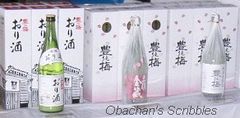 It was a real eye-opening day for me. I went to a town named Akaoka with a friend of mine to visit a local sake brewery. I had been to Akaoka once before in summer to see a famous “sake-drinking festival,” but I didn’t know much about the town itself or other attractions there. One of the new findings that day was this: As of November 2005, Akaoka is officially “the smallest town in Japan (area-wise).” It has been ranked as the smallest since the beginning of this year because the ex-smallest town in Nagasaki pref. merged into a bigger city then.
It was a real eye-opening day for me. I went to a town named Akaoka with a friend of mine to visit a local sake brewery. I had been to Akaoka once before in summer to see a famous “sake-drinking festival,” but I didn’t know much about the town itself or other attractions there. One of the new findings that day was this: As of November 2005, Akaoka is officially “the smallest town in Japan (area-wise).” It has been ranked as the smallest since the beginning of this year because the ex-smallest town in Nagasaki pref. merged into a bigger city then.
Why did I decide to visit a sake brewery there? Well, for the past couple of months, I’ve been doing a little net search for my foodblog entries on fermented foods such as miso and soy sauce, and in doing so, my interest was gradually directed to our No.1 local product, sake. Yes, for us, Kochi is not Kochi without sake. And when I found out about the “brewery tour” at several sake breweries in Kochi, my curiosity drove me to go for it. I picked this small brewery, Takagi Shuzo (Brewery) in Akaoka, because its location was convenient for me and my friend, and sake-tasting was included in the tour ;)
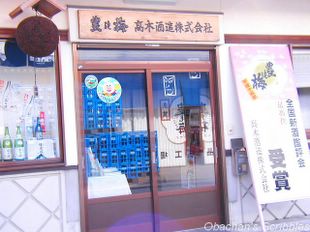
At the brewery, young president, Mr. Takagi welcomed us (with his right arm in plaster! ) and gave us a tour. First he showed us several kinds of rice used for sake-making.
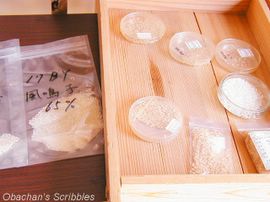
He told us that good sake rice has larger kernel, shinpaku (high starch concentration in the core) and softer texture that allows the milling to sometimes less than 50% of the original grain. The more polished, the better the quality and fragrance will be. Sake made from the rice that were milled to 60% or less of the original size is called ginjo-shu. Now I understand why the premium sake, daiginjo, is such a luxury-- more than half of the rice grain is milled away!! In addition to the ever famous sake rice, “Yamada nishiki,” there were also samples of Kochi-grown sake rice. We also learned about the different types of sake and the process of sake-making.
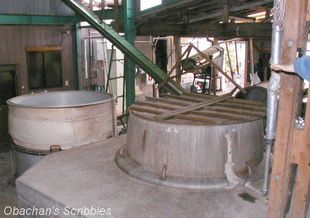 This is the big steamer they use for steaming sake rice. Mr. Takagi said that only steaming can prepare rice properly for koji rice mold making; boiling or roasting does not work.
This is the big steamer they use for steaming sake rice. Mr. Takagi said that only steaming can prepare rice properly for koji rice mold making; boiling or roasting does not work.
 Now, the first big eye-opener was what I learned about yeast and the fragrance. Before that, I didn’t believe that sake had a “fruity" fragrance, because I never had a chance to drink expensive kind, ginjo-shu, which is said to have such fragrance. Sake is made from rice, not fruits. So I thought the word “fruity” was some kind of metaphor, an expression borrowed from wine-making or something. WRONG! For the first time I learned that esters produced by yeast have real banana- or melon- or apple-like aroma, and they give sake literally “fruity” fragrance.
Now, the first big eye-opener was what I learned about yeast and the fragrance. Before that, I didn’t believe that sake had a “fruity" fragrance, because I never had a chance to drink expensive kind, ginjo-shu, which is said to have such fragrance. Sake is made from rice, not fruits. So I thought the word “fruity” was some kind of metaphor, an expression borrowed from wine-making or something. WRONG! For the first time I learned that esters produced by yeast have real banana- or melon- or apple-like aroma, and they give sake literally “fruity” fragrance.
Another thing I learned that day was the meaning of the measurement called shudo酒度 or nihonshu-do日本酒度, which is an indicator of how sweet/dry the sake is (and technically the specific gravity of sake). The larger number of shudo with “+ (plus)” means less sugar content (and more alcohol?) as a result of longer fermentation, thus a dryer taste. The larger shudo with “- (minus)“ means more sugar content from a shorter fermentation, thus a sweeter taste.
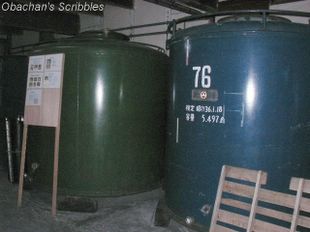 I think these tanks were the ones we saw in the Shikomi-room (fermentation room?), IIRC. There, more rice, koji and water are added to the starter in 3 times and the fermentation takes place to form the mash called moromi. (That reminded me of feeding my sourdough starter.) He also told us about pasteurization, and said that Japanese brewers were already doing a similar thing in sake-production way before Pasteur started pasteurization.
I think these tanks were the ones we saw in the Shikomi-room (fermentation room?), IIRC. There, more rice, koji and water are added to the starter in 3 times and the fermentation takes place to form the mash called moromi. (That reminded me of feeding my sourdough starter.) He also told us about pasteurization, and said that Japanese brewers were already doing a similar thing in sake-production way before Pasteur started pasteurization.
 This compressor(?) is used to press sake out from moromi mash. Mr. Takagi also told us about the extraction method that uses bags and allows sake to drip out -- the method used to make their best-quality sake for contests. At this point I wasn’t really convinced that the different extraction methods would make such a great difference in the flavor of the final products.
This compressor(?) is used to press sake out from moromi mash. Mr. Takagi also told us about the extraction method that uses bags and allows sake to drip out -- the method used to make their best-quality sake for contests. At this point I wasn’t really convinced that the different extraction methods would make such a great difference in the flavor of the final products.
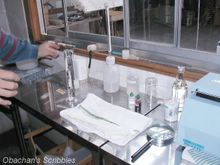 He also took us to a small room and showed us the equipments used for measuring the specific gravity. He said that acidity and amino-acid content are also measured there.
He also took us to a small room and showed us the equipments used for measuring the specific gravity. He said that acidity and amino-acid content are also measured there.
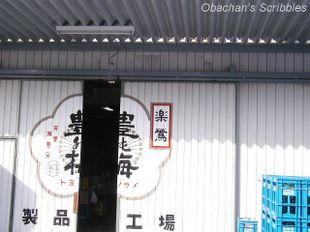
After the tour, Mr. Takagi took us to a storage room. It was finally the moment I’d been waiting for… time for tasting sake! And what I experienced there completely changed my view on sake. Details are here on my foodblog :)
----
 Mr. Takagi brought us back to the office after the sake-tasting and showed us some other materials including the photos of the tornados that hit Kochi in 1994. He said one of them came above this brewery and disappeared, causing no damage to the facility.
Mr. Takagi brought us back to the office after the sake-tasting and showed us some other materials including the photos of the tornados that hit Kochi in 1994. He said one of them came above this brewery and disappeared, causing no damage to the facility.
I also asked him about the “space sake” project that I read on the paper the other day. He said many breweries in Kochi are involved in the project and they will all use the rice and yeast that came back from the space but each brewery would choose a production method (such as how much to mill the rice and how to extract, etc.) that they like. The final products will be categorized as “Tosa uchu-shu (Tosa space sake)” and each brewery will give their product whatever name they like, and according to the brewing method chosen, the price would vary. One of the only two master brewers in Kochi works there at Takagi brewery, so I believe their uchu-shu will be an excellent one.
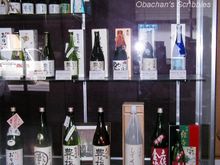 Before attending the tour, I did a little net search to learn the basics of sake-making and English terms, because I thought my friend might like some explanations in English. The website that was most helpful to me was this, and the moment I told Mr. Takagi about the site, he immediately said “Is that John Gauntner's site ?” He said Mr. Gauntner was a leading authority of sake outside Japan.
Before attending the tour, I did a little net search to learn the basics of sake-making and English terms, because I thought my friend might like some explanations in English. The website that was most helpful to me was this, and the moment I told Mr. Takagi about the site, he immediately said “Is that John Gauntner's site ?” He said Mr. Gauntner was a leading authority of sake outside Japan.
During the tour, Mr. Takagi helped me with some English terms, so I assumed that he had a fairly good English skill. When I asked if he would give a tour in English, he said he would need to mix English and Japanese sometimes. With the English panphlet they have there, I think it's possible for a non-Japanese speaker to get the basic idea of sake-making and enjoy the tour at this brewery.
It was such an eye-opening, interesting experience that introduced me to a new interest. Now I’m so tempted to try many different kinds of sake and find my "most favorite,” and try various combinations with appetizers/meals. :)
Takagi Shuzo
http://www.toyonoume.com/
(Japanese only)
 It was a real eye-opening day for me. I went to a town named Akaoka with a friend of mine to visit a local sake brewery. I had been to Akaoka once before in summer to see a famous “sake-drinking festival,” but I didn’t know much about the town itself or other attractions there. One of the new findings that day was this: As of November 2005, Akaoka is officially “the smallest town in Japan (area-wise).” It has been ranked as the smallest since the beginning of this year because the ex-smallest town in Nagasaki pref. merged into a bigger city then.
It was a real eye-opening day for me. I went to a town named Akaoka with a friend of mine to visit a local sake brewery. I had been to Akaoka once before in summer to see a famous “sake-drinking festival,” but I didn’t know much about the town itself or other attractions there. One of the new findings that day was this: As of November 2005, Akaoka is officially “the smallest town in Japan (area-wise).” It has been ranked as the smallest since the beginning of this year because the ex-smallest town in Nagasaki pref. merged into a bigger city then.Why did I decide to visit a sake brewery there? Well, for the past couple of months, I’ve been doing a little net search for my foodblog entries on fermented foods such as miso and soy sauce, and in doing so, my interest was gradually directed to our No.1 local product, sake. Yes, for us, Kochi is not Kochi without sake. And when I found out about the “brewery tour” at several sake breweries in Kochi, my curiosity drove me to go for it. I picked this small brewery, Takagi Shuzo (Brewery) in Akaoka, because its location was convenient for me and my friend, and sake-tasting was included in the tour ;)

At the brewery, young president, Mr. Takagi welcomed us (with his right arm in plaster! ) and gave us a tour. First he showed us several kinds of rice used for sake-making.

He told us that good sake rice has larger kernel, shinpaku (high starch concentration in the core) and softer texture that allows the milling to sometimes less than 50% of the original grain. The more polished, the better the quality and fragrance will be. Sake made from the rice that were milled to 60% or less of the original size is called ginjo-shu. Now I understand why the premium sake, daiginjo, is such a luxury-- more than half of the rice grain is milled away!! In addition to the ever famous sake rice, “Yamada nishiki,” there were also samples of Kochi-grown sake rice. We also learned about the different types of sake and the process of sake-making.
 This is the big steamer they use for steaming sake rice. Mr. Takagi said that only steaming can prepare rice properly for koji rice mold making; boiling or roasting does not work.
This is the big steamer they use for steaming sake rice. Mr. Takagi said that only steaming can prepare rice properly for koji rice mold making; boiling or roasting does not work. Now, the first big eye-opener was what I learned about yeast and the fragrance. Before that, I didn’t believe that sake had a “fruity" fragrance, because I never had a chance to drink expensive kind, ginjo-shu, which is said to have such fragrance. Sake is made from rice, not fruits. So I thought the word “fruity” was some kind of metaphor, an expression borrowed from wine-making or something. WRONG! For the first time I learned that esters produced by yeast have real banana- or melon- or apple-like aroma, and they give sake literally “fruity” fragrance.
Now, the first big eye-opener was what I learned about yeast and the fragrance. Before that, I didn’t believe that sake had a “fruity" fragrance, because I never had a chance to drink expensive kind, ginjo-shu, which is said to have such fragrance. Sake is made from rice, not fruits. So I thought the word “fruity” was some kind of metaphor, an expression borrowed from wine-making or something. WRONG! For the first time I learned that esters produced by yeast have real banana- or melon- or apple-like aroma, and they give sake literally “fruity” fragrance.Another thing I learned that day was the meaning of the measurement called shudo酒度 or nihonshu-do日本酒度, which is an indicator of how sweet/dry the sake is (and technically the specific gravity of sake). The larger number of shudo with “+ (plus)” means less sugar content (and more alcohol?) as a result of longer fermentation, thus a dryer taste. The larger shudo with “- (minus)“ means more sugar content from a shorter fermentation, thus a sweeter taste.
 I think these tanks were the ones we saw in the Shikomi-room (fermentation room?), IIRC. There, more rice, koji and water are added to the starter in 3 times and the fermentation takes place to form the mash called moromi. (That reminded me of feeding my sourdough starter.) He also told us about pasteurization, and said that Japanese brewers were already doing a similar thing in sake-production way before Pasteur started pasteurization.
I think these tanks were the ones we saw in the Shikomi-room (fermentation room?), IIRC. There, more rice, koji and water are added to the starter in 3 times and the fermentation takes place to form the mash called moromi. (That reminded me of feeding my sourdough starter.) He also told us about pasteurization, and said that Japanese brewers were already doing a similar thing in sake-production way before Pasteur started pasteurization. This compressor(?) is used to press sake out from moromi mash. Mr. Takagi also told us about the extraction method that uses bags and allows sake to drip out -- the method used to make their best-quality sake for contests. At this point I wasn’t really convinced that the different extraction methods would make such a great difference in the flavor of the final products.
This compressor(?) is used to press sake out from moromi mash. Mr. Takagi also told us about the extraction method that uses bags and allows sake to drip out -- the method used to make their best-quality sake for contests. At this point I wasn’t really convinced that the different extraction methods would make such a great difference in the flavor of the final products. He also took us to a small room and showed us the equipments used for measuring the specific gravity. He said that acidity and amino-acid content are also measured there.
He also took us to a small room and showed us the equipments used for measuring the specific gravity. He said that acidity and amino-acid content are also measured there.
After the tour, Mr. Takagi took us to a storage room. It was finally the moment I’d been waiting for… time for tasting sake! And what I experienced there completely changed my view on sake. Details are here on my foodblog :)
----
 Mr. Takagi brought us back to the office after the sake-tasting and showed us some other materials including the photos of the tornados that hit Kochi in 1994. He said one of them came above this brewery and disappeared, causing no damage to the facility.
Mr. Takagi brought us back to the office after the sake-tasting and showed us some other materials including the photos of the tornados that hit Kochi in 1994. He said one of them came above this brewery and disappeared, causing no damage to the facility.I also asked him about the “space sake” project that I read on the paper the other day. He said many breweries in Kochi are involved in the project and they will all use the rice and yeast that came back from the space but each brewery would choose a production method (such as how much to mill the rice and how to extract, etc.) that they like. The final products will be categorized as “Tosa uchu-shu (Tosa space sake)” and each brewery will give their product whatever name they like, and according to the brewing method chosen, the price would vary. One of the only two master brewers in Kochi works there at Takagi brewery, so I believe their uchu-shu will be an excellent one.
 Before attending the tour, I did a little net search to learn the basics of sake-making and English terms, because I thought my friend might like some explanations in English. The website that was most helpful to me was this, and the moment I told Mr. Takagi about the site, he immediately said “Is that John Gauntner's site ?” He said Mr. Gauntner was a leading authority of sake outside Japan.
Before attending the tour, I did a little net search to learn the basics of sake-making and English terms, because I thought my friend might like some explanations in English. The website that was most helpful to me was this, and the moment I told Mr. Takagi about the site, he immediately said “Is that John Gauntner's site ?” He said Mr. Gauntner was a leading authority of sake outside Japan.During the tour, Mr. Takagi helped me with some English terms, so I assumed that he had a fairly good English skill. When I asked if he would give a tour in English, he said he would need to mix English and Japanese sometimes. With the English panphlet they have there, I think it's possible for a non-Japanese speaker to get the basic idea of sake-making and enjoy the tour at this brewery.
It was such an eye-opening, interesting experience that introduced me to a new interest. Now I’m so tempted to try many different kinds of sake and find my "most favorite,” and try various combinations with appetizers/meals. :)
Takagi Shuzo
http://www.toyonoume.com/
(Japanese only)
posted by obachan, 11/23/2005 10:59:00 PM


